Pachysentis
Pachysentis is a genus of parasitic spiny-headed (or thorny-headed) worms.
| Pachysentis | |
|---|---|
 | |
| Proboscis of P. lenti[1] | |
| Scientific classification | |
| Kingdom: | Animalia |
| Phylum: | Acanthocephala |
| Class: | Archiacanthocephala |
| Order: | Oligacanthorhynchida |
| Family: | Oligacanthorhynchidae |
| Genus: | Pachysentis Meyer, 1931 |
Taxonomy
Pachysentis has not been included in phylogenetic analyses thus far,[2] and is categorized based on morphological features. Phylogenetic analyses have been conducted on Oncicola, a genus morphological nearly identical to Pachysentis apart from the number of hooks on the proboscis, and have placed it in the family Oligacanthorhynchidae.
| Archiacanthocephala | |||||||||||||||||||||||||||||||||
| |||||||||||||||||||||||||||||||||
| Phylogenetic reconstruction for select species in the class Archiacanthocephala[3][4] |
Description

Pachysentis look identical to the closely related Oncicola apart from the number of hooks on the proboscis. Species of Oncicola have 36 or less hooks whereas species of Pachysentis have more. Specifically, the proboscis is not quite spherical and contains 42 to 102 hooks arranged into 12 longitudinal rows 3 to 12 hooks each. The rows may be regularly or irregularly alternating and straight or crooked. Hooks have tips with or without barbs, and the larger hooks with complex manubria and roots with the remaining spines being rootless. The trunk is fairly wide relative to the length with the anterior half usually wider than the posterior half. The testes are in tandem with at least one located before the middle of the worm. There are eight cement glands compactly arranged each with single giant nucleus used to temporarily close the posterior end of the female after copulation.[5][6] The eggs have a sculptured outer membrane. Hosts include Brazilian or Egyptian carnivores. Species can be distinguished based on the number and arrangements of proboscis hooks, whether these hooks are barbed, the arrangement of the cement glands, host, and the length of lemnisci.[1]
Species
| P. angolensis | ||
|---|---|---|
| Measurements[1] | Female (mm) | Male (mm) |
| Length of proboscis | 0.55-0.63 | |
| Width of proboscis | 0.70–0.82 | |
| Length of proboscis receptacle | 1.5 | |
| Length of trunk | 34-48 | 17-23 |
| Width of trunk | 4.8–5.5 | 3.5–4 |
| Length of lemnisci | 5.8–6 | |
| Size of anterior testes | 2–3 × 0.9 | |
| Size of posterior testes | 2–4.3 × 1.0 | |
| Dimension of group of cement gland | - | 3 |
| Ejaculatory duct length | - | 2.3 |
| Size of eggs in mm | 0.09 × 0.043 | - |
| P. canicola | ||
|---|---|---|
| Measurements[1] | Female (mm) | Male (mm) |
| Length of proboscis | 0.57-0.80 | |
| Width of proboscis | 0.57–0.85 | |
| Length of proboscis receptacle | 2 | |
| Length of trunk | 20–26 | 15-28 |
| Width of trunk | 5-11 | 4-8 |
| Length of lemnisci | 7 | |
| Size of anterior testes | 2 | |
| Size of posterior testes | 2 | |
| Dimensions of cement glands | 3 | |
| Uterine bell | 3. 15–8.15 | |
| Size of eggs in mm | 0.07 × 0.045 | |
| P. dollfusi | ||
|---|---|---|
| Measurements[1] | Female (mm) | Male (mm) |
| Length of trunk | 50 | 50 |
| Width of trunk | 4 | 4 |
| Length of lemnisci | 4.3–6.6 | |
| Size of eggs in mm | 0.08 × 0.05 | |
| P. ehrenbergi | ||
|---|---|---|
| Measurements[1] | Female (mm) | Male (mm) |
| Length of proboscis | 0.8 | |
| Width of proboscis | 0.9 | |
| Length of proboscis receptacle | 1.3 | |
| Length of trunk | 26-29 | 25 |
| Width of trunk | 6 | 4 |
| Length of lemnisci | 7 | |
| Width of lemnisci | 0.8 | |
| Size of anterior testes | 3 | |
| Size of posterior testes | 3 | |
| Dimension of group of cement gland | 7 | |
| Size of eggs in mm | 0.07 × 0.05 | |
| P. gethi | ||
|---|---|---|
| Measurements[1] | Female (mm) | Male (mm) |
| Length of proboscis | 0.583 | |
| Width of proboscis | 0.794 | |
| Length of proboscis receptacle | 1.07 | |
| Width of proboscis receptacle | 0.498 | |
| Length of trunk | 15–25 | 10–15 |
| Width of trunk | 1.5–3 | 1.0–2.5 |
| Length of lemnisci | 3.48 | |
| Size of anterior testes | 1.40 × 0.581 | |
| Size of posterior testes | 1.40 × 0.581 | |
| Dimension of cement glands | 1.54 | |
| Ejaculatory duct length | 4.64 | |
| Uterine bell | 5.56 | |
| Size of eggs in mm | 0.084 × 0.054 | |
| P. lauroi | ||
|---|---|---|
| Measurements[1] | Female (mm) | Male (mm) |
| Length of proboscis | 0.68 × 0.76 | |
| Width of proboscis | 0.68 × 0.76 | |
| Length of proboscis receptacle | 1.16 × 0.47 | |
| Width of proboscis receptacle | 1.16 × 0.47 | |
| Length of trunk | 12.07 × 1.62 | 9.63 × 1.91 |
| Width of trunk | 12.07 × 1.62 | 9.63 × 1.91 |
| Length of lemnisci | 4.45 | |
| Size of anterior testis | 1.15 × 0.48 | |
| Size of posterior testis | 1.27 × 0.55 | |
| Dimension of group of cement gland | 0.86 × 0.56 | |
| Ejaculatory duct length | 1.42 | |
| Uterine bell | 1.19 | |
| Size of eggs | 0.073 × 0.045 | |
| P. lenti | ||
|---|---|---|
| Measurements[1] | Female (mm) | Male (mm) |
| Length of proboscis | 0.63 | |
| Width of proboscis | 0.664 | |
| Length of proboscis receptacle | 1.32 | |
| Length of trunk | 20–25 | 15–20 |
| Width of trunk | 2–2.5 | 1.0–2.5 |
| Length of lemnisci | 3.15 | |
| Size of anterior testis | 1.76 × 0.51 | |
| Size of posterior testis | 1.82 × 0.547 | |
| Dimension of group of cement gland | 2.98 | |
| Uterine bell | 1.41 | |
| P. procumbens | |
|---|---|
| Measurements[1] | Juvenile (mm) |
| Length of proboscis | 0.55 |
| Width of proboscis | 0.55 |
| Length of proboscis receptacle | 1.2 |
| Length of trunk | 6 |
| Width of trunk | 1.25 |
| P. procyonis | ||
|---|---|---|
| Measurements[1] | Female (mm) | Male (mm) |
| Length of proboscis | 0.697 | |
| Width of proboscis | 0.716 | |
| Length of proboscis receptacle | 1.37 | |
| Width of proboscis receptacle | 0.531 | |
| Length of trunk | 25-35 | 20-30 |
| Width of trunk | 2–3 | 2–3 |
| Length of lemnisci | 3.64 | |
| Size of anterior testes | 3.01 × 1.24 | |
| Size of posterior testes | 3.15 × 1.07 | |
| Dimension of group of cement glands | 3.56 | |
| Ejaculatory duct length | 3.53 | |
| Uterine bell | 4.64 | |
| Size of eggs in mm | 0.071 × 0.042 | |
| P. rugosus | ||
|---|---|---|
| Measurements[1] | Female (mm) | Male (mm) |
| Length of proboscis|colspan="2" | 0.564 | |
| Width of proboscis | 0.694 | |
| Length of proboscis receptacle | 1.24 | |
| Width of proboscis receptacle | 0.481 | |
| Length of trunk | 32 | 25 |
| Width of trunk | 3 | 3.5 |
| Dimension of group of cement glands | 2.02 | |
| Length of lemnisci | 4.64 | |
| Size of anterior testes | 1.57 × 0.697 | |
| Size of posterior testes | 1.69 × 0.664 | |
| Ejaculatory duct length | 2.02 | |
| Uterine bell | 5.86 | |
The genus Pachysentis Meyer, 1931 contains eleven species, however P. septemserialis has an uncertain taxonomic status.[1][7][lower-alpha 1]
- Pachysentis angolensis (Golvan, 1957)[lower-alpha 2]
P. angolensis was found infesting the Side-striped jackal (Canis adustus) in Angola. The proboscis has a total of 42 hooks without barbs arranged in six rows of four hooks followed by six rows of three hooks.[1] The species name angolensis derives from the country, Angola, where it was discovered.[9]
- Pachysentis canicola Meyer, 1931
P. canicola was found infesting the Red fox (Vulpes vulpes) in Bushehr, Bushehr Province, Iran,[10] a gray fox (Urocyon cinereoargenteus) in the United States, the Striped skunk (Mephitis mephitis), the American hog-nosed skunk (Conepatus leuconotus) and the Western spotted skunk (Spilogale gracilis) in North America, and a domestic dog (the type host) in Brazil. It is the type species. The proboscis contains 72 hooks without barbs arranged into six rows of four hooks followed by twelve rows of four hooks.[1] Intermediate hosts include Western diamondback rattlesnake (Crotalus atrox) found in Texas, United States.[11] P. canicola was also found infesting the golden jackal, (Canis aureus) in Iran.[12]
- Pachysentis dollfusi (Machado-Filho, 1950)
P. dollfusi was found infesting the Common brown lemur (Eulemur fulvus) in a Brazilian zoo but originally from the island of Madagascar. It is thus unknown if the worm originates from Brazil or Madagascar. The proboscis has 48 barbed hooks arranged into six rows of four hooks each followed by six rows of four hooks each. The cement glands are in uniform pairs.[1]
- Pachysentis ehrenbergi Meyer, 1931
P. ehrenbergi was found infesting the red fox (Vulpes vulpes) in Egypt. The proboscis is armed with 102 barbed hooks arranged into six rows of nine hooks each followed by six rows of eight hooks each. [1] The worm was also found inside the body cavity of 5.4% of the African five-lined skink (Trachylepis quinquetaeniata reported as Mabuya quinquetaeniata) sampled in the Qena Governorate, Egypt. The trunk is cylindrical and measures 2.6–3.7 mm in length and 0.78–0.83 mm in width in the female and measures 3–3.9 mm. in length and 0.81–0.84 mm in the much smaller male. The proboscis is relatively circular and is 0.40–0.46 mm long and 0.37–0.43 mm wide in the female and 0.46–0.49 mm long and 0.38–0.42 mm wide in the male. The proboscis contains longitudinal rows of 18 recurved hooks each. The proboscis receptacle is cylindrical, has two walls and measures 0.80–0.95 mm long and 0.36–0.39 mm wide in the female and 0.89–0.95 mm long and 0.36–0.40 mm wide in the male. The testes are oval and measures 0.20–0.26 mm by 0.10–0.14 mm. An intermediate host is the Egyptian cobra (Naja haje).[1]
- Pachysentis gethi (Machado-Filho, 1950)[13]
P. gethi was found infesting the Tayra (Eira barbara) in Pará and Rio de Janeiro, Brazil. The proboscis has 42 hooks without barbs arranged into six rows of four hooks followed by six rows of three hooks. The eight cement glands occur in pairs.[1]
- Pachysentis lauroi Gomes, Amin, Olifiers, Bianchi, Souza, Barbosa & Maldonado, 2019[1]
P. lauroi has been found infesting the South American coati (Nasua nasua) in Mato Grosso do Sul, Brazil. The proboscis has 48 barbed hooks arranged into six rows of four hooks followed by six rows of four hooks. The eight cement glands are clustered. [1]
- Pachysentis lenti (Machado-Filho, 1950)
P. lenti has been found infesting the White-headed marmoset (Callithrix geoffroyi) in Espirito Santo, Brazil. The proboscis has 48 hooks without barbs arranged into six rows of four hooks followed by six rows of four hooks.[1]
- Pachysentis procumbens Meyer, 1931
P. procumbens has been found infesting the red fox (Vulpes vulpes) in Argo, Egypt. The proboscis has 90 hooks without barbs arranged into six rows of seven hooks followed by six rows of eight hooks. [1]
- Pachysentis procyonis (Machado-Filho, 1950)
P. procyonis was found infesting the Crab-eating raccoon (Procyon cancrivorus) in Rio de Janeiro, Brazil. The proboscis has 42 hooks without barbs arranged into six rows of four hooks followed by six rows of three hooks. Distinguishing features include eight clustered cement glands and very short lemnisci that do not reach the anterior testis.[1]
- Pachysentis rugosus (Machado-Filho, 1950)
P. rugosus have been found infesting Azaras's capuchin (Sapajus cay) in Rio de Janeiro, Brazil. The proboscis is armed with 42 hooks without barbs arranged into six rows of four hooks each followed by six rows of three hooks each. This species can be identified by their clustered cement glands and long leminisci that reach the anterior testis. [1]
- Pachysentis septemserialis (Machado-Filho, 1950)
P. septemserialis is considered to have uncertain taxonomic status by Gomes (2019) due to the differences between the paratypes morphological characteristics and those of the original description, the similarity in hosts (primates of the family Callitrichidae), and the absence of samples or measurements of adult males. Specifically, the original description of one paratype described the lack of a collar at the base of the proboscis whereas a collar was observed (suggesting affiliation with the genus Prosthenorchis). A second discrepancy from another paratype is the incorrect number of hooks; 12 longitudinal rows of four hooks with total of 48 hooks were observed but contradicts the seven rows of seven hooks with a total of 49 hooks given in the original description. Morphologically, new observations suggests it is synonymous with P. lenti.[1]
Hosts
Pachysentis species exclusively parasitize carnivourous mammals as their primary host. Reptilian intermediate hosts have been found for P. ehrenbergi and P. canicola.
- Hosts for Pachysentis species
-_rare_sighting_of_this_nocturnal_animal_..._(13799300905).jpg.webp) The Side-striped jackal is one of the hosts of P. angolensis
The Side-striped jackal is one of the hosts of P. angolensis.jpg.webp)
_male.jpg.webp) The Common brown lemur is one of the hosts of P. dollfusi
The Common brown lemur is one of the hosts of P. dollfusi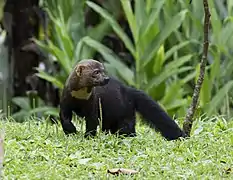 The Tayra is one of the hosts of P. gethi
The Tayra is one of the hosts of P. gethi The South American coati is one of the hosts of P. louroi
The South American coati is one of the hosts of P. louroi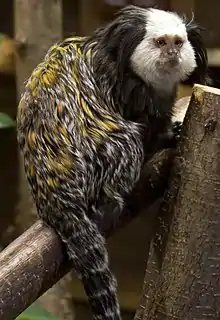 The White-headed marmoset is one of the hosts of P. lenti
The White-headed marmoset is one of the hosts of P. lenti.jpg.webp) The Crab-eating raccoon is one of the hosts of P. procyonis
The Crab-eating raccoon is one of the hosts of P. procyonis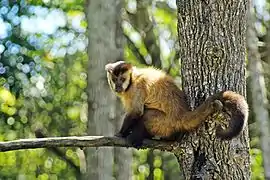 The Azaras's capuchin is one of the hosts of P. rugosus
The Azaras's capuchin is one of the hosts of P. rugosus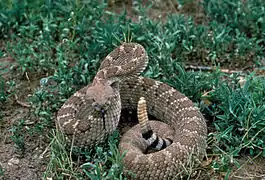 The Western diamondback rattlesnake is an intermediate hosts of P. canicola
The Western diamondback rattlesnake is an intermediate hosts of P. canicola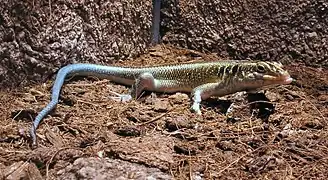 The African five-lined skink is an intermediate hosts of P. ehrenbergi
The African five-lined skink is an intermediate hosts of P. ehrenbergi
Notes
- A binomial authority in parentheses indicates that the species was originally described in a genus other than the present genus.
- P. angolensis was originally named Oncicola angolensis by Golvan in 1957 but was renamed by Schmidt in 1972 .[7][8]
References
- Gomes, Ana Paula N.; Amin, Omar M.; Olifiers, Natalie; Bianchi, Rita de Cassia; Souza, Joyce G. R.; Barbosa, Helene S.; Maldonado, Arnaldo (2019). "A New Species of Pachysentis Meyer, 1931 (Acanthocephala: Oligacanthorhynchidae) in the Brown-Nosed Coati Nasua nasua (Carnivora: Procyonidae) from Brazil, with Notes on the Genus and a Key to Species". Acta Parasitologica. 64 (3): 587–595. doi:10.2478/s11686-019-00080-6. PMC 6814649. PMID 31286360.
- "Search NCBI databases".
- Nascimento Gomes, Ana Paula; Cesário, Clarice Silva; Olifiers, Natalie; de Cassia Bianchi, Rita; Maldonado, Arnaldo; Vilela, Roberto do Val (December 2019). "New morphological and genetic data of Gigantorhynchus echinodiscus (Diesing, 1851) (Acanthocephala: Archiacanthocephala) in the giant anteater Myrmecophaga tridactyla Linnaeus, 1758 (Pilosa: Myrmecophagidae)". International Journal for Parasitology: Parasites and Wildlife. 10: 281–288. doi:10.1016/j.ijppaw.2019.09.008. PMC 6906829. PMID 31867208.
- Amin, O.M.; Sharifdini, M.; Heckmann, R.A.; Zarean, M. (2020). "New perspectives on Nephridiacanthus major (Acanthocephala: Oligacanthorhynchidae) collected from hedgehogs in Iran". Journal of Helminthology. 94: e133. doi:10.1017/S0022149X20000073. PMID 32114988.
- Bush, Albert O.; Fernández, Jacqueline C.; Esch, Gerald W.; Seed, J. Richard (2001). Parasitism : the diversity and ecology of animal parasites. Cambridge, UK New York, NY: Cambridge University Press. p. 203. ISBN 0-521-66278-8. OCLC 44131774.
- Kükenthal, W (2014). Gastrotricha and Gnathifera. Göttingen, Germany: Walter de Gruyter. p. 322. ISBN 978-3110274271.
- "Oligacanthorhynchidae Petrochenko, 1956". Integrated Taxonomic Information System (ITIS). 20 May 2020. Retrieved 20 May 2020.
- Amin, Omar M. (19 September 2013). "Classification of the Acanthocephala". Folia Parasitologica. 60 (4): 273–305. doi:10.14411/fp.2013.031. PMID 24261131.
- Golvan YJ (1957) Acanthocéphales de l’Angola. I. Oncicola angolensis n. sp. (Archiacanthocephala, Pachysentidae), parasite du chacal Canis adustus Sundevall. Publicacion Servicos Culturais de la Companhia de Diamantes de Angola, Museo do Dundo 34:39–50
- Tavakol, Sareh & Amin, Omar & Luus-Powell, Wilmien & Halajian, Ali. (2015). The acanthocephalan fauna of Iran, a check list. Zootaxa. 4033. 237-258. 10.11646/zootaxa.4033.2.3.|url=https://www.researchgate.net/publication/283153130_The_acanthocephalan_fauna_of_Iran_a_check_list
- Carbajal-Márquez, Rubén Alonso; González-Solís, David; Cedeño-Vázquez, J. Rogelio (2018). "Endoparasites of Crotalus tzabcan (Serpentes: Viperidae), with a checklist in rattlesnakes". Journal of Parasitic Diseases. 42 (2): 303–314. doi:10.1007/s12639-018-1001-3. PMC 5962485. PMID 29844637.
- Gherman, Călin Mircea; Mihalca, Andrei Daniel (2017). "A synoptic overview of golden jackal parasites reveals high diversity of species". Parasites & Vectors. 10 (1): 419. doi:10.1186/s13071-017-2329-8. PMC 5603039. PMID 28915831.
- Muniz-Pereira, Luís C.; Corrêa, Pilar; Bueno, Cecília; Vieira, Fabiano M. (2016). "Rediscovery of Pachysentis gethi (Acanthocephala: Oligacanthorhynchidae), a parasite of wild lesser grison Galictis cuja (Carnivora: Mustelidae) from Brazil". Revista Mexicana de Biodiversidad. 87 (4): 1356–1359. doi:10.1016/j.rmb.2016.10.010.
External links
 Data related to Pachysentis at Wikispecies
Data related to Pachysentis at Wikispecies